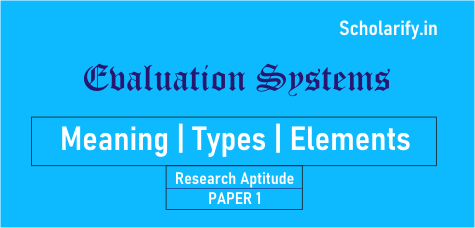
Evaluation Systems: Evaluation is a process through which we can get an exact idea of what students actually achieve from their teaching-learning experiences.
Evaluation Systems
UGC defined as:
Evaluation is the process of making judgments based on evidences and interpretations gathered through examination and assessment and on the basis of agreed upon criteria.
Assessment: It is the process of collecting, recording, scoring, describing, and interpreting information about learning.
Examination: it is a quantitative measure of learners’ performance and is usually held at the end of the academic session or semester.
According to Tuckman: “Evaluation is a process wherein the parts, process or outcomes of the programme are examined to see whether they are satisfactory, particularly with reference to the programs stated objectives of our own standards of excellence.”
According to Moffatt: “Evaluation is a continuous process and is concerned with more than the formal academic achievement of the students. It is interested in the development of the individual in terms of the desirable behavioural changes in relation to his feelings and actions.”
Characteristics of Evaluation Systems in Education
- Continuous process: Evaluation is a continuous process. It leads together with Teaching-learning process.
- Comprehensive: Evaluation is comprehensive as it includes everything can be evaluated.
- Learners-Centered: Evaluation is a learner-centered process which gives importance to the learning process, not to the teaching process.
- Remedial: Evaluation comments on the result which helps in remedial work it is not a remedy Evaluation is remedial in nature.
- Cooperative process: Evaluation is a cooperative process involving students, teachers, parents, and peer-groups.
- Teaching Methods: Effectiveness of teaching methods is evaluation.
- Common practice: Evaluation is a common practice among the proper growth of the child mentally and physically.
- Multiple Aspects: it is concerned with the total personality of students.
Elements of Evaluation Systems
Five essential elements of evaluation systems:
(1) Audience,
(2) Purpose,
(3) Questions
(4) Scope, and
(5) Resources
To determine these elements, the following questions should be considered:
- For what audience is the evaluation being conducted?
- For what purpose is the evaluation being conducted?
- What questions will be asked in the evaluation?
- What is the scope of the evaluation?
- What resources are available to conduct the evaluation?
Process of Evaluation Systems
The process of evaluation for teaching-learning system comprises of four major steps. The stages are the following:
- Setting Objectives and Criteria
- Development and Use of Measurement instruments
- Interpretation of Collected Data
- Formulation of Judgments and taking of appropriate Action
Types of Evaluation Systems
In the various form of instruction, evaluation is integrated. There are four types of evaluation systems are Placement, Formative, Diagnostic, and Summative.
Placement evaluation: It determines the knowledge and skills the students possess, which are necessary at the beginning of instruction in a given subject area. The purpose of placement evaluation is to check the aptitude of a candidate for the course or subject, whether the candidate has caliber or not. Various entrance exams can also be conducted for the same purpose. This is also done to see the knowledge base of students, and a teacher can start discussion keeping that in view.
Formative evaluation: A formative evaluation (also referred to as internal evaluation) is a method for judging the worth of a programme while the programme activities are in progress. It focuses on the process. This evaluation provides the student with feedback regarding his or her success or failure in attaining the instructional objectives. It also identifies the specific learning error that needs to be corrected.
For instance, a student learns and scores high on the objective part of the test but fails in the essay part; he is reinforced to exert more effort in answering essay questions in the succeeding tests. For a teacher, formative evaluation provides information for making instructions and remedies more effective. Quizzes, unit tests, and chapter tests are examples of evaluative instruments used in this type of evaluation.
Diagnostic evaluation: The formative evaluation determines the extent to which students accomplish the learning targets; therefore, it focuses on the measurement of the intended outcomes. The diagnostic evaluation goes a step further and tries to provide an explanation for the possible causes for problems in learning. Diagnostic tests are, thus, more comprehensive and detailed.
Summative evaluation (external evaluation): Summative evaluation is a method of judging the worth of a programme at the end of the programme activities (summation). The focus is on the outcome. It determines the extent to which objectives of instruction have been achieved and is used for assigning course grades. Summative evaluation generally includes oral reports, projects, term papers, and teacher-made achievement tests, and it shows how good or how satisfactory the student is in accomplishing the objectives of instruction.
References:
https://physicscatalyst.com/gradation/evaluation-in-education/
https://www.gangainstituteofeducation.com/BhartiyamJournal/QualityEdcationthroughNewEvaluationMethods.pdf
https://www.ugc.ac.in/pdfnews/9555132_Guidelines.pdf
Related Topics:
UGC NET Syllabus (Updated): Paper 1 and 2 (Download)
Solved Question Papers of UGC NET Paper 1
UGC NET Study Materials for Paper 1 (Download PDF)
MPhil and PhD Fellowship